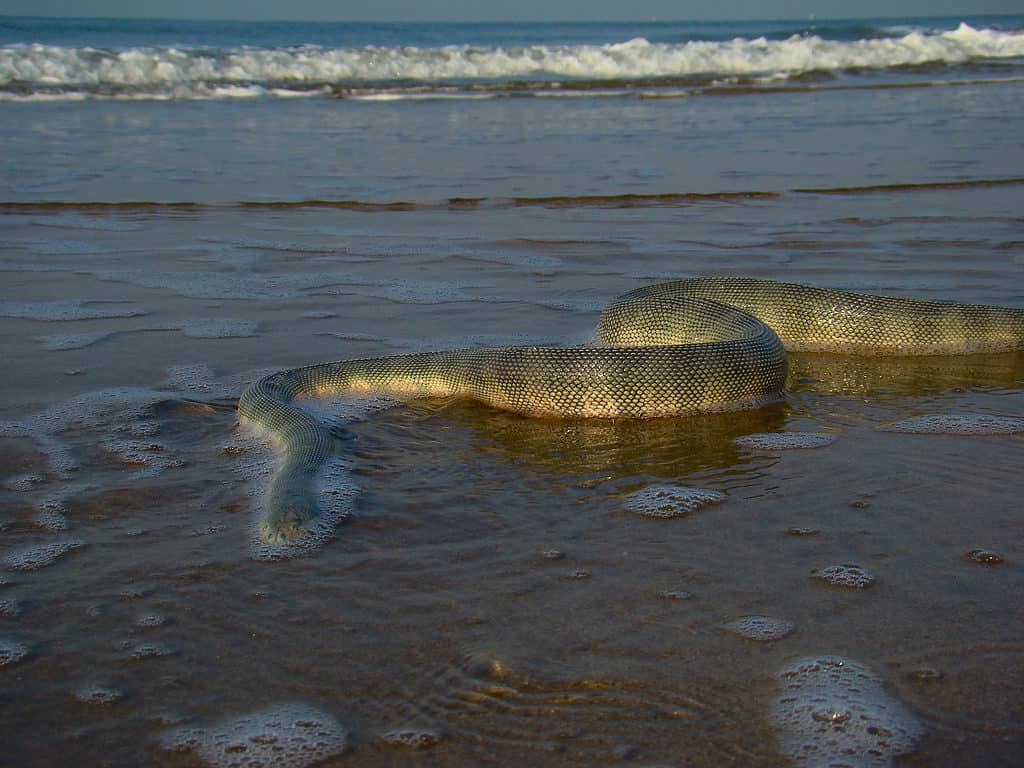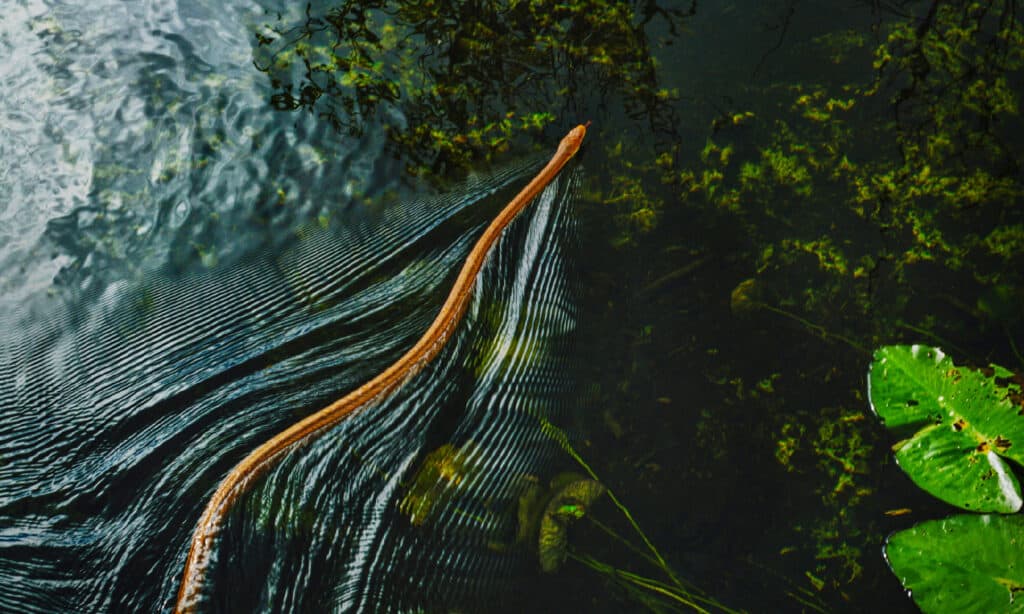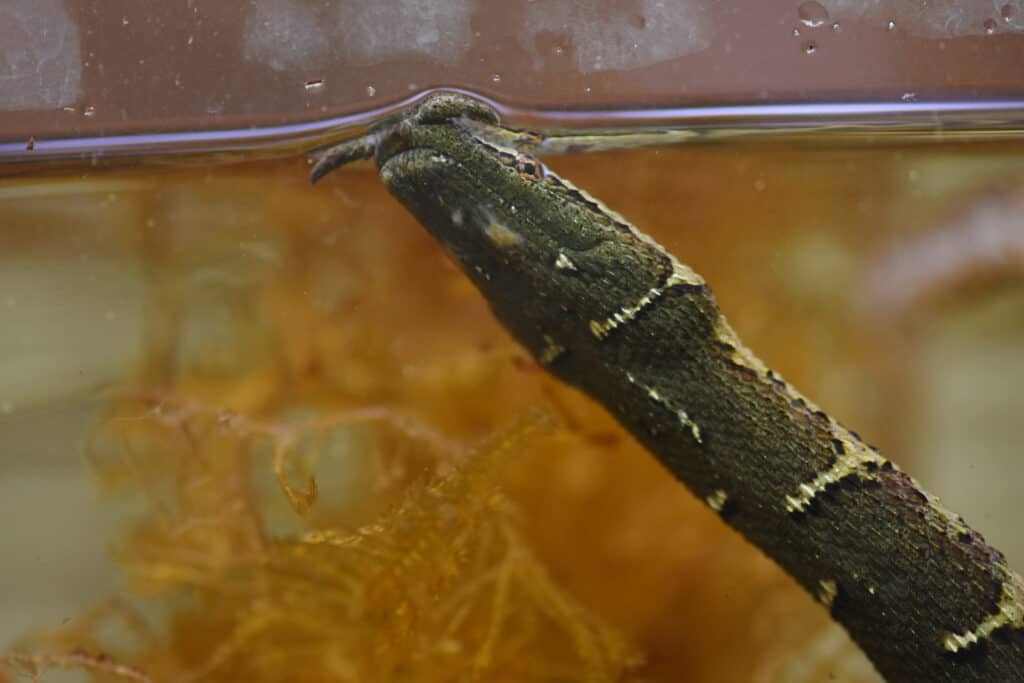Lake Erie, the fourth largest of North America’s five Great Lakes, is a fantastic location for swimmers and fishermen. It’s home to a variety of fish and aquatic life. Of late, there have been concerns about the safety of swimming in the lake’s waters due to claims of an increase in the number of snakes dwelling there.
There are people that believe that this snake invasion has led to a significant decline in fish populations. Others maintain that these aquatic reptiles aren’t dangerous to people. What we need to do is to look at the data and research this topic in order to gain a deeper understanding of this problem. We can then decide whether swimming in Lake Erie is risk-free for everyone.
When the summer heat becomes too much, seeking respite at nearby watering holes is common. However, what if apprehension arises due to the possibility of poisonous snakes lurking in those waters? Reports have surfaced lately about snakes inhabiting bodies of water near Lake Erie.
Naturally, this causes fear among those seeking a haven to cool off. To alleviate your concerns, let’s investigate in depth what impact snake sightings might have concerning public safety and ecological stability. Mindfully sifting through authentic data can help separate fact from fiction for better clarity surrounding such situations.

Exploring the Serpent’s Presence in Lake Erie
Lake Erie is known for its varied wildlife. This magnificent freshwater lake has pelicans, seagulls, diverse fish species, and snakes. The truth is that snakes have coexisted with other creatures within and around Lake Erie for centuries.
Reports from the mid-1800s show that water snakes were plentiful throughout the watershed. Moreover, these serpentine creatures have been valuable as they play an essential role in balancing the ecosystems by preying on smaller fish.

Snakes are an integral part of the ecosystem in Lake Erie, providing important ecological balance by controlling populations of smaller fish and amphibians.
©Laurie L. Snidow/Shutterstock.com
Sneaky Swimmers: Identifying and Characterizing Snakes in Lake Erie
Today, sightings of snakes in Lake Erie are more commonplace. Water snakes and garter snakes are two species commonly found in the waters near shorelines or islands within the lake. Water snakes typically have brown or gray backs with yellow or brown bellies, while garters are characterized by slender bodies with distinctive stripes running from head to tail.
Through close observation and state-of-the-art methods such as infrared cameras, acoustic tagging, and advances in genetics and ecology, we are now able to study the behavior of snakes in Lake Erie and identify different species.
Snakes found in Lake Erie include the eastern garter snake, northern water snake, western ribbon snake, black rat snake, milk snake, and eastern hog-nosed snake. Poisonous snakes found in the area include timber rattlesnakes and copperheads, and eastern massasauga.
As for their behavior patterns, these snakes tend to be shy and avoid human interaction whenever possible. If confronted or threatened, however, water snakes will display aggressive behavior by inflating their bodies and hissing loudly. Garter snakes would instead attempt to flee.
Amid the deep blue waters of Lake Erie, one may spot a movement. Peering more profoundly, one can see a slinky swimmer emerging from its watery abode towards the surface. The movement becomes clearer with sight as their garter belt gives way to hindquarters.
Originally thought to have been long-lost pets, snake populations have made themselves at home in Lake Erie waters and contribute significantly to an abundance found around rocky shores like Put-in-Bay and Pelee Island, where many tourists love to swim during summers.
Water snake populations come out full force at nighttime when they hunt for food like small fish and frogs. While some vacationers may find these creatures fascinating up close, others might find them frightening.

While snakes may look intimidating, they tend to do no harm. Knowing where to look and how to properly identify them is key to giving them a safe distance.
©jmarino/Shutterstock.com
Snake Sightings: Fact, Fiction, or Perception?
Recent reports suggest that there is an increased number of snakes in Lake Erie. While some celebrate this different animal sighting type, others raise concerns about safety and the ecosystem.
Local authorities have received more calls from residents and visitors claiming to have seen snakes swimming near their boats or sunbathing on rocks along the shorelines. This perceived rise in snake numbers has caused unease among those who use the lake recreationally, despite reports showing a consistent population count for water snakes for over 20 years.
However, researchers argue that there is no concrete evidence of an increase in the number of snakes in Lake Erie. In fact, they claim that fluctuations among these populations usually result from seasonal variations such as climatic conditions and prey abundance rather than actual population increases.
The debate around snake populations mirrors other controversies where people tend to panic about wildlife numbers. The community can change its perceptions based on what they hear over time.
Through encouraging various beliefs about “too many” or “not enough” animals, the media frenzy could take a while for scientific fact-checking processes to retract or confirm. Nonetheless, officials must always stay vigilant and educate the public regarding these sightings while simultaneously promoting safety precautions to minimize risk.

Lake Erie is home to a variety of snake species, including the northern water snake (
Nerodia sipedon), which can be seen swimming in its waters.
©Tim Malek/Shutterstock.com
Navigating Eco-Tourism and Conservation: Finding Balance with Lake Erie’s Snake Population
In recent years, there’s been an increased effort from animal advocates to mitigate the misconceptions surrounding snakes in Lake Erie. These creatures often get a bad rap, thanks to movies and mythology portraying them as dangerous and malicious. Advocates emphasize that these snakes play a vital role in Lake Erie’s intricate ecosystem, assisting in controlling fish populations while keeping everything balanced.
This issue has also impacted eco-tourism, where some tourists visit specific locations only for snake observation. Regulatory authorities estimate tourist participation of over two million each year interested in snake sightings along shoreline rocks for well-known photography at South Bass Island or Toledo Harbor Lighthouse.
Harmonizing the demands of eco-tourism and conservation can pose difficulties. Those committed to preserving wildlife recognize the crucial role of safeguarding their habitats while respecting their natural food chain. They support creature safety protocols by advising humans to maintain a safe distance if they see one while exploring the lake’s vicinity.
The value of striking a balance is crucial between being a cautious observer and a reckless disruptor towards Mother Nature to ensure the preservation of natural ecosystems like those existing at Lake Erie.
Animal advocates are encouraging more public-education initiatives, insisting on providing facts about snakes’ behavior during sightings while discouraging public hysteria. Thorough education can help make visitors and residents aware of what measures they should take if confronted with these small yet essential life forms around the lake area, which would reduce unnecessary harm significantly.

Non-venomous reptiles, such as the northern water snake have adapted to the lake’s environment and can be found throughout its waters. They feed on fish, frogs, and even small birds.
©IHX/Shutterstock.com
Don’t Get Caught Off Guard: Essential Safety Tips for Snake Encounters in Lake Erie
Picture this: after years of putting it off, you’ve finally decided to dip in Lake Erie. The water is refreshing, and the sun shines on you; everything seems perfect. Suddenly, you spot a snake moving fast toward you in the water! Panic sets in; what are you supposed to do? Will it bite you?
While snakes are often harmless and vital members of Lake Erie’s ecosystem, there’s always a chance that one could use its fangs for defense when feeling threatened or bothered. It becomes crucial then for visitors or residents who might chance upon them now and again to understand basic safety protocols against venomous species.
Symptoms of Venomous Snake Bites
It’s essential to learn about symptoms commonly associated with venomous snake bites, such as redness around the area bitten coupled with swelling or tingling sensations. Early first aid efforts like resting near the affected area and elevating above the victim’s heart may be helpful; however, professional medical help should always follow.
Furthermore, toxins from pit vipers like copperheads can cause deathly effects on nervous systems, such as muscle weakness or respiratory failure, if left untreated long enough, according to doctors’ confirmation at St. Vincent Charity Hospital, Cleveland.
Emergency Process for Handling Bitten Victims
In case of snake bites by poisonous serpents – keep calm. Go straight to any emergency room without wasting much time after calling 911. Once their EMTs confirm a person has been bitten by venomous snakes, having tetanus shots and other antivenom medication requirements will ensure better recovery outcomes, potentially saving victims’ lives altogether.
Preventive Methods Against Possible Attacks
The National Park Service advises visitors along popular walking trails around regions known for having significant growths of plants and vegetation beneficial for sustaining diverse animal life forms to wear proper footwear. At the same time, tourists should be mindful of natural habitats growing there by minimizing unnecessary disturbances which may inadvertently put them at risk.
Visitors and residents can also reduce their risk of snake attacks by keeping a safe distance when encountering one. Instead of panicking or interacting with snakes, keep a safe thirty feet distance for maximum safety whenever sighted.
While the probability of snake bites around Lake Erie remains low, it’s always important to take precautionary measures against potential hazards. Visitors and residents should educate themselves on basic animal encounter safety procedures to make informed decisions while remaining in awe of Lake Erie’s natural wonders without fearfulness.

To protect against snake bites, it is best to wear thick boots and long pants when walking in areas where snakes may be present.
©Scott Delony/Shutterstock.com
The Domino Effect of Upsetting Lake Erie’s Ecosystem: What Role Do Snakes Play?
Imagine a jigsaw puzzle nestled together with intricately carved pieces, each one of them significant to the overall picture it produces. This is quite similar to how Lake Erie’s ecosystem works, with its different residents and habitats playing specific roles and interdependent upon each other to keep the chain of life flowing smoothly.
Snakes, for instance, might not be an everyday sight around Lake Erie; however, they still play essential roles in keeping everything balanced. They help control the fish population and reduce rodent populations from coastal regions while serving as prey for birds like hawks or eagles nesting around.
Snakes are an essential piece of Lake Erie’s intricate puzzle. Without them, the ecosystem’s balance tips out of control, impacting everything else. Unfortunately, human actions such as dumping toxic pollutants and disrupting the water supply can cause severe issues like botched oxygen provision, putting various species at risk – including snakes.
These delicate creatures may die off quickly if their habitat becomes compromised with no natural predators to keep balance achievable. This ultimately pushes some vulnerable species toward the brink of extinction, compromising the ecosystem’s overall health.
The receding of marshlands around the lake has put certain species, such as bog frogs, fish, and snakes, at risk of becoming endangered. Snakes, especially small copperhead snakes, are essential for regulating the number of amphibians that can overpopulate and deplete resources. They are also essential for controlling insect populations that can cause major damage to habitats and decrease the quality of water. When the snake population is disrupted, the impacts can be devastating for the entire region.
Small copperhead snakes keep the conditions hospitable for larger animal populations by consuming frogs, insects, and small mammals. In turn, larger mammals like bald eagles, herons, and raccoons benefit from cleaner waters and abundant prey that the snakes help provide. The ecology needs a careful balance between predators and prey, which is maintained by doing this.
The environment will be affected if there is a fall in the snake population. Because there are fewer snakes to control their population, small rodent and bug populations soar, destroying neighboring crops and necessitating culling and more environmental damage. A surplus of other predators, including raccoons and owls, who further reduce prey populations, is also brought on by the threat of pest management.
When human development threatens this balance, Lake Erie’s delicate ecosystem is put in jeopardy.

The environment will be affected if there is a fall in the snake population.
©iStock.com/David_Camarillo
Is it safe to swim?
If you’re planning to dip your toes in Lake Erie this summer, you may wonder if it’s safe with snakes lurking around. Now, let’s get one thing straight – Lake Erie indeed has snakes. But before you jump into panic mode, let’s analyze the risks of encountering them while swimming.
First things first, several factors influence snake activity and movement. Here are the key ones:
- Temperature: As cold-blooded reptiles, their physiological makeup influences their body temperature based on environmental temperatures. Snakes generally prefer temperatures ranging from 80-90 °F. Unforeseeable weather variations can impact this balance leaving them distressed and vulnerable.
- Water quality: These predators need fresh and clean drinking sources for survival.
- Food availability: Snakes feed on small mammals or birds to maintain tough predatory activity levels. When prey availability becomes scarce, local populations of predators reduce as well.
Contrary to popular belief, snakes typically try to avoid human interaction unless threatened or forced into harm’s way. Day-to-day and hour-to-hour variations make predicting encounters difficult with outdoor participants. Nonetheless, if you encounter them by accident, be watchful, do not engage, and keep a safe distance. Rest assured – there’s no need for concern when sharing a common space.
Precautions To Take
Although the chance of encountering snakes while swimming is low, taking some simple precautions can reduce your risk even further:
1. Dawn and dusk are when snakes are most active. Avoid swimming during these times.
2. If you will be near tall grassy areas where snakes may hide, wear protective clothing such as closed-toe shoes or long-sleeved shirts and trousers.
3. Respect their territory – remember, you’re only a visitor.
4. If you do see one slithering toward you – don’t panic! Slowly move away from it without any sudden movements.
By following these precautions and being aware of your surroundings at all times at Lake Erie, you’ll significantly reduce any chances of encountering a snake.

Be mindful when out on Lake Erie’s waters – there may be hidden dangers beneath the surface! Take necessary precautions to ensure a safe and enjoyable outing.
©Keung/Shutterstock.com
The Slithery Scare: How To See Snakes While Making Waves?
Snakes have always had a somewhat dubious reputation in the public eye – with tales of their wily schemes and venomous bites floating around like fish in the sea. But is this perception entirely accurate or more myth than fact? Read on to know more.
Various Folklore Stories Surrounding Snakes
For centuries, snakes have been surrounded by an air of mystery, leading to numerous folklore stories surrounding them. From ancient tales of Medusa’s petrifying gaze to the famous apple that forever changed the fate of humankind in the Garden of Eden.
These myths and legends still shape our perception and attitudes towards snakes today – both positive and negative. Some believe they’re symbols of transformation, eternity, rebirth, or healing, while others view them as evil omens or deceitful predators biding their time for their next victim.
However, it’s important to remember that not everything you hear about snakes is accurate. Just like any other animal, they play a crucial role in maintaining the natural balance within an ecosystem.
Correct information should always be at the forefront when dealing with dangerous species like snakes. You can better prepare yourself and avoid misunderstandings by learning to interact with these animals securely.
Authorities must disseminate accurate information regarding snake encounters so that people can make informed decisions based on facts rather than fear or ignorance. This includes details on identification, behavior patterns, and safety measures when encountering these reptiles in open waters or other areas near Lake Erie.
Incorrect information can lead to misplaced fears or aggressive actions towards snakes that could harm both humans and these creatures, leading to an unnecessary conflict between man and nature.

Snakes have been seen as symbols of power, wisdom, and knowledge throughout many cultures for centuries.
©Alyssa Metro/Shutterstock.com
Swim with Confidence: Diving into a Safe and Serpentine Lake Erie
Swimming in Lake Erie is a wonderful way to appreciate nature, but you must be prepared for the possibility of encountering slithering serpents. Though their presence might inspire fear, taking preventative measures and understanding snake behavior can make coexisting safely easy.
It’s impossible to deny the raw beauty and mysterious allure of snakes, so don’t let that fear stand in the way of all that this majestic lake has to offer. Keep a lookout for any snakes you may come across, and show them due respect as fellow inhabitants of this spectacular planet. So don’t be afraid – dip your toes in the water, cast a line, and enjoy – all with a watchful eye out for sly serpents.
The photo featured at the top of this post is © iStock.com/Dalene Capps
Discover the "Monster" Snake 5X Bigger than an Anaconda
Every day A-Z Animals sends out some of the most incredible facts in the world from our free newsletter. Want to discover the 10 most beautiful snakes in the world, a "snake island" where you're never more than 3 feet from danger, or a "monster" snake 5X larger than an anaconda? Then sign up right now and you'll start receiving our daily newsletter absolutely free.
Thank you for reading! Have some feedback for us? Contact the AZ Animals editorial team.






